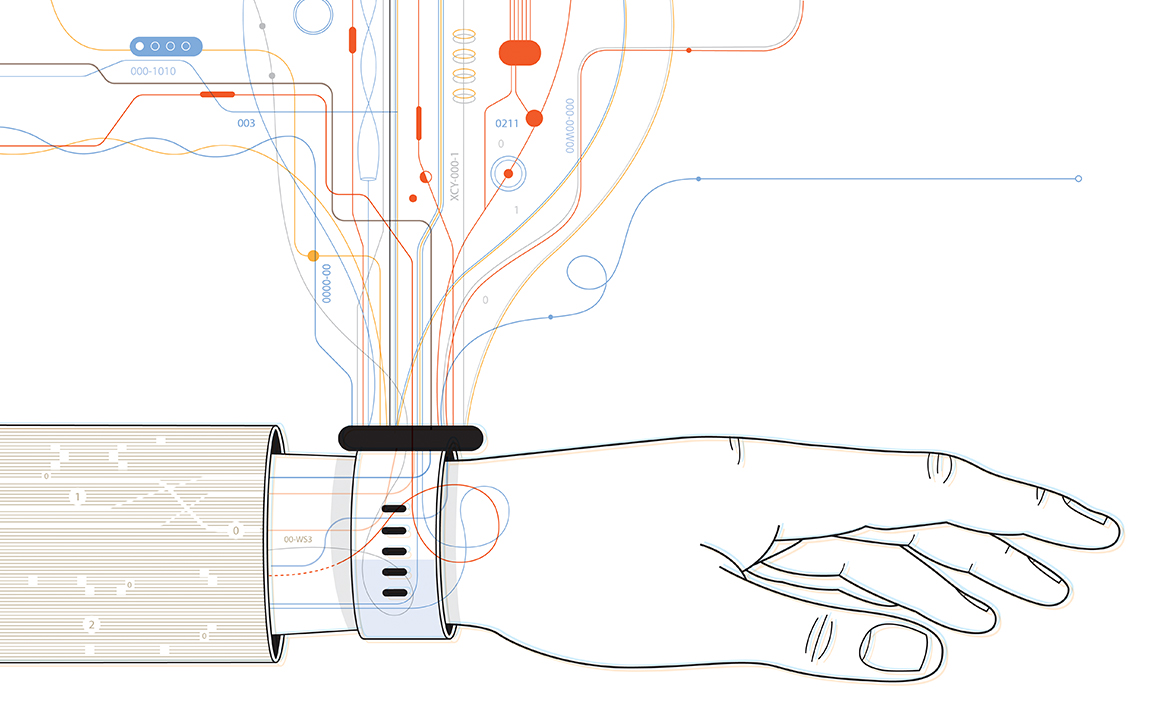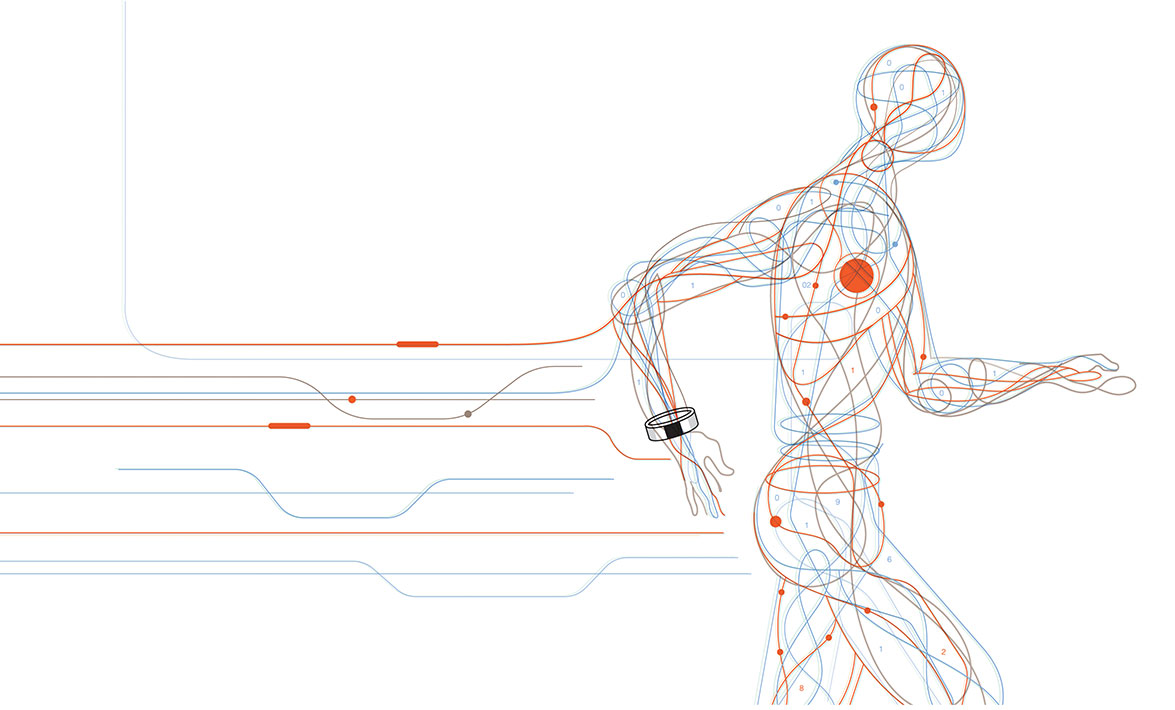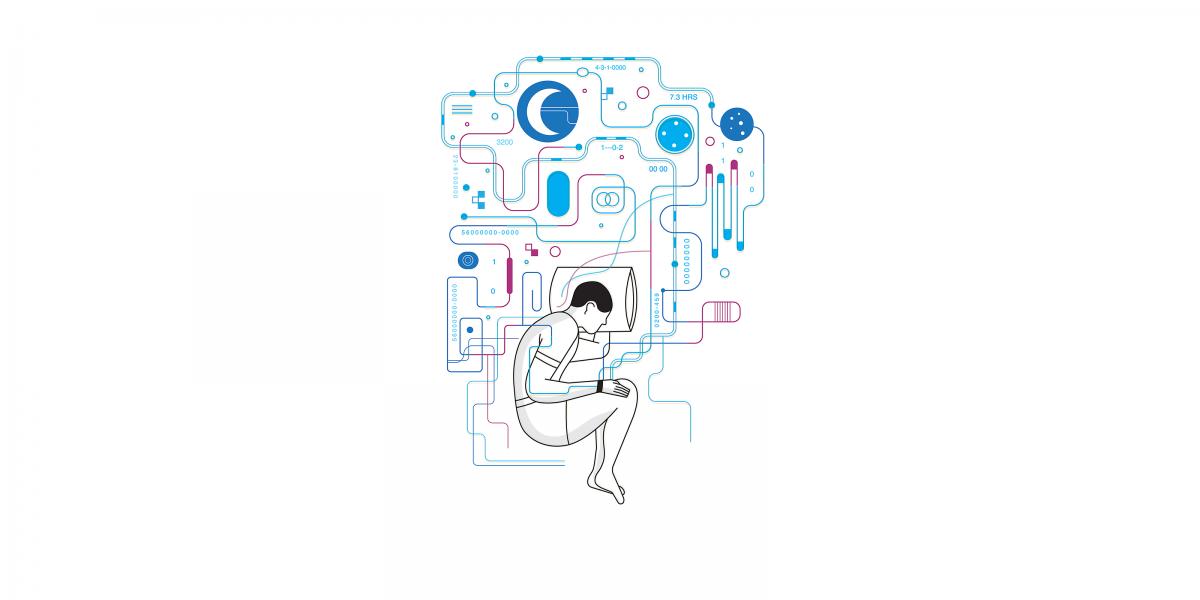How Wearable and Implantable Technology is Changing the Future of Health Care
5 ways mobile sensors are changing public health.
Vadim Zipunnikov has seen the future, and it’s on your wrist. Or implanted in your body.
Mobile sensors are doing everything from monitoring our movements and sleep to recording the electrical activity in our hearts 24/7 as we go about our daily routines. As a result, the technology is quickly becoming indispensable for researching ways to manage illness and improve health.
“It’s really exploding right now,” says Zipunnikov, PhD, MS, an assistant professor in Biostatistics and co-leader of the Wearable and Implantable Technology group.
He and his colleagues are using wearable and implantable devices to better understand major public health issues ranging from frailty among the elderly to sleep deprivation among adolescents. They are mining mobile sensor data to predict bipolar disorder, improve patient recovery after heart surgery and monitor disability among people with multiple sclerosis. And they are employing wearables to untangle the web of connections between sleep, physical activity and Alzheimer’s disease.
“People talk about personalized medicine, but no one talks about personalized public health recommendations,” says Zipunnikov. “But they should all be personalized, at least at the level of age and gender, and, with the help of wearable technology, truly personalized.”
Here are five ways that mobile sensors—and the mountains of data they generate—are changing public health.
Get Up and Stay Up
People’s physical lives are fragmented. A sprint to the bus or a harried car commute may be followed by hours of sitting at a desk and then, maybe, a workout at the gym. How do an individual’s broken-up bouts of activity affect her health? What does the proportion of active to sedentary periods look like at different times of day—and does it matter?
In work that is yet to be published, a team of Zipunnikov’s colleagues, including Junrui Di, a doctoral student in Biostatistics, and Jacek Urbanek, PhD, an assistant professor of Geriatric Medicine and Gerontology in the School of Medicine, found that mortality is associated with patterns of sedentary and active time accumulation—and that these patterns are important beyond the total amount of time that people spend being active or sedentary. These findings have been confirmed in two large national studies, the Baltimore Longitudinal Study of Aging and the National Health and Nutrition Examination Survey.
Already, Zipunnikov says, they’ve learned enough to know that it’s best to break up sedentary time with frequent bursts of activity—and to avoid settling back down again too quickly.
“In other words,” he says, “once you get up from your chair, try to stay up and move around as long as possible.”
Jennifer Schrack, PhD ’11, an associate professor in Epidemiology, is using Zipunnikov’s methods to better understand the relationships between the patterns of physical activity captured by wearables and health outcomes related to aging and disease processes.
To that end, she’s examining differences in patterns of activity among men with and without HIV; investigating the link between physical activity and fatigability among cancer survivors; and exploring the possibility of using changes in motor activity, with and without data from brain scans, to capture the onset and progression of Alzheimer’s disease in older adults.
Bodies at Rest
Mobile sensors aren’t just changing the way we look at physical activity, however. They’re also changing the way we understand sleep.
Adam Spira, PhD, has spent years using sleep data to unpack the relationships between sleep patterns, circadian rhythms and health outcomes ranging from hospitalization to cognitive decline.
“Sleep is linked to so many different dimensions of health that it’s sort of astounding,” says Spira, an associate professor in Mental Health.
Wearable sensors have made it cheaper and easier to gather sleep data since study participants can now contribute data while sleeping in their own beds rather than in a sleep clinic.
The data flood allows researchers like Spira to extract information and identify patterns that would otherwise go unnoticed.
The results can seem magical.
Zipunnikov is currently helping Spira and his colleague Paul Rosenberg, MD, a professor of Psychiatry and Behavioral Sciences at the School of Medicine, analyze data from two cohorts of healthy older adults who are at risk of developing Alzheimer’s disease: one with evidence of amyloid plaques in their brains, and the other without. Participants in the first cohort receive either a drug designed to reduce amyloid plaques or a placebo.
Researchers know there is a strong connection between sleep disturbances and poor cognitive performance. And they suspect that sleeping well might protect against cognitive decline, while sleeping poorly might invite it. But precisely how sleep and cognitive decline mutually interact remains something of a mystery.
Spira therefore hopes to compare the circadian rhythms of people with and without amyloid plaques, and to determine what effect clearing those plaques might have on their sleep patterns.
Preliminary results do show differences between the circadian rhythms of people who have amyloid plaques and those who don’t. But, Spira says, those differences only become clear with Zipunnikov’s novel biostatistical techniques. They reveal fine-grained variations in circadian rhythms among individuals at different times of day—variations that wouldn’t have materialized under traditional methods.
Spira hopes to use such information to create targeted interventions to help safeguard cognitive performance, such as adjusting an individual’s physical activity at particular times of day or using cognitive behavioral therapy to modify their sleep patterns—all without resorting to the sedatives commonly prescribed for sleep problems, which can increase the risk of falls and even cognitive decline in older adults.

Mind-Body Connection
The study of mental health, too, is changing thanks to the mobile sensor revolution.
For example, Zipunnikov is also helping to analyze data on physical activity, sleep and mood for Kathleen Merikangas, PhD, an adjunct professor in Epidemiology and Mental Health and chief of the Genetic Epidemiology Research Branch at the National Institute of Mental Health.
Merikangas is using wearables to collect physical activity and sleep data in a study of more than 2,000 people in the U.S. and Switzerland. She augments that data with self-reports on mood, stress and energy sent via smartphone, as well as saliva samples to monitor cortisol levels, a biomarker for stress.
By capturing people’s behaviors and perceptions in real time, Merikangas hopes to better understand depression, bipolar disorder, migraines and other mental and neurological conditions. In a JAMA Psychiatry paper co-authored with Zipunnikov, Merikangas found to her surprise that mood did not predict physical activity or sleep; rather, physical activity predicted mood. In addition, people with a history of bipolar disorder were more sensitive to disturbances in all the interrelated domains of physical activity, sleep, mood and energy, indicating that they may have difficulty establishing regular rhythms of any kind—including circadian ones.
“We now can see these dynamic within-day interactions between activity, sleep, mood, stress and anxiety,” says Zipunnikov.
The findings suggest that health care providers might one day be able to manage mood disorders by helping patients establish regular physical activity and sleep routines.
Zipunnikov directs the biostatistical core of the Mobile Motor Activity Research Consortium for Health, an NIMH-funded international initiative led by Merikangas that combines wearables and smartphone apps to investigate mood disorders across multiple international sites. In addition to writing algorithms to combine and jointly analyze data from different sensors, he’s also helping to develop an online platform that will allow member sites to share this multimodal data—something that would boost the statistical power of their studies.
But he is particularly excited about a new project that focuses on schoolchildren. Together, Merikangas and Zipunnikov are working on a plan to bring the multimodal methodology they developed for Merikangas’s family study to high school students. The goal is to identify students experiencing problems with sleep, mood, anxiety and related systems so that they can be referred for behavioral modification strategies and ultimately treatment. A new app designed to administer these procedures is now being tested in a large sample of children in New York.
“When you’re an adult, it’s very hard to change your sleep, exercise, dietary habits and other health behaviors,” says Zipunnikov. “And statistically speaking, by making changes and establishing healthy routines as early as possible, you can not only significantly shorten the exposure period, but also make the lifelong trajectory more robust—and physical and mental health more resilient.”
Quickly Exploding Data
The great data boom from wearables and implantable sensors has a downside, of course: information overload.
As Jacek Urbanek notes, an accelerometer can record hundreds of observations per second. Monitor hundreds or thousands of those sensors continuously for a week or two, he says, and the amount of data on your hands “will explode very quickly.”
And consider the challenge of interpreting data from a wrist-worn accelerometer. Was that sudden uptick in a person’s readings from jogging or playing the violin? Motor patterns from one person’s housework may resemble another person’s impaired sleep.
Just establishing standards for cleaning, labeling, formatting and storing all that complex, messy data so that it can be subjected to rigorous statistical analysis takes a lot of time and requires important data processing skills.
What’s more, the kind of data provided by mobile sensors—dense, multilevel and collected continuously by multiple sensors over the course of days if not weeks—is not necessarily amenable to analysis by existing statistical methods. Zipunnikov and his fellow biostatisticians are therefore working on developing novel statistical methods to discover otherwise invisible patterns buried in the data.“One of the things I’ve learned from Vadim,” says Adam Spira, “is that we can squeeze a lot more out of this data than is conventionally squeezed.”
Measuring the Unmeasurable
Wearable and implantable sensors are great for measuring physical phenomena. But mood, energy or stress? Not so much.
Nor do they provide the context needed to put their objective measurements into perspective: Why was a study participant unusually sluggish on Tuesday morning? Why was their sleep unusually disturbed on Monday night?
Yet all of that information is crucial to mental health research.
Psychologists gather such data by asking people to jot down what they are doing, thinking and feeling moment-to-moment throughout the day. Originally these so-called ecological momentary assessments were recorded with pen and paper, but today researchers like Kathleen Merikangas employ smartphone apps.
Merikangas and Zipunnikov are tracking participants’ mood, energy, anxiety and other states based on responses to prompts sent four times per day to their mobile phones. Participants also answer questions about context, physical health, stress and diet, which can provide powerful information on the triggers of migraines, depression, alcohol or drug use, or even suicide attempts.
“They give us an efficient way to obtain measures of health as well as changes in people’s perceptions over time,” says Merikangas, who adds that combining physical and emotional data should allow researchers to identify the sources of stress in an individual’s daily life.
Zipunnikov, meanwhile, dreams of a day when people will receive automated, just-in-time intervention messages (“Hey, you seem stressed; time to relax and exercise!”) through the same devices that record their feelings.

